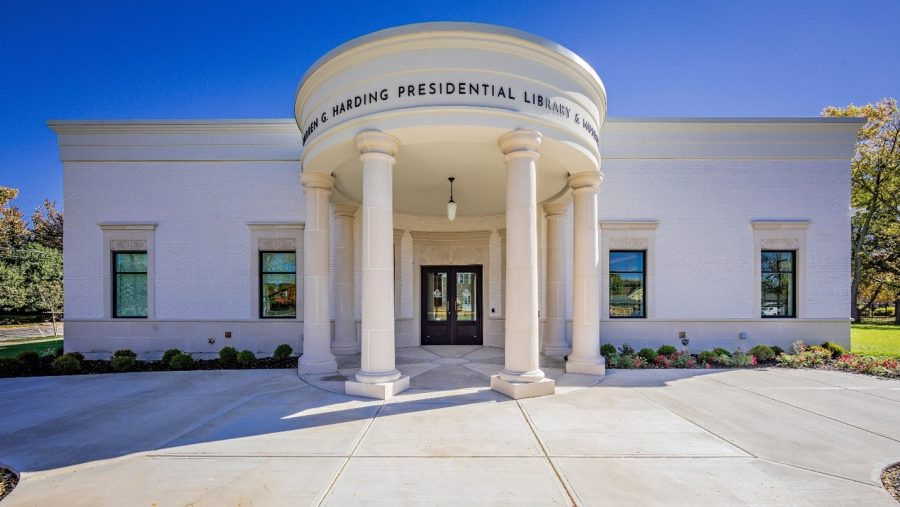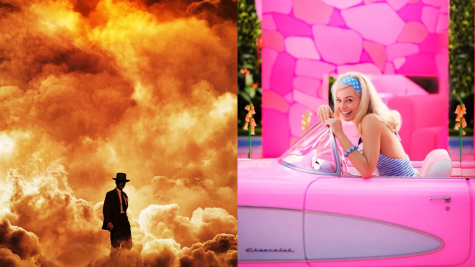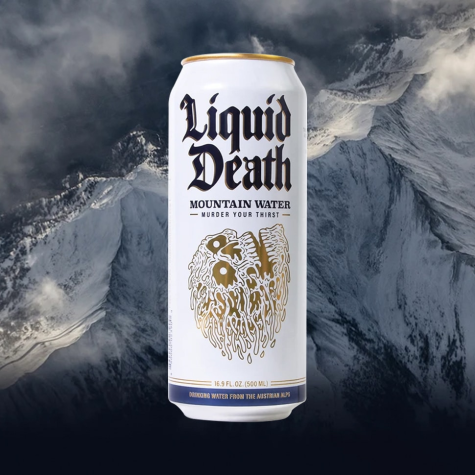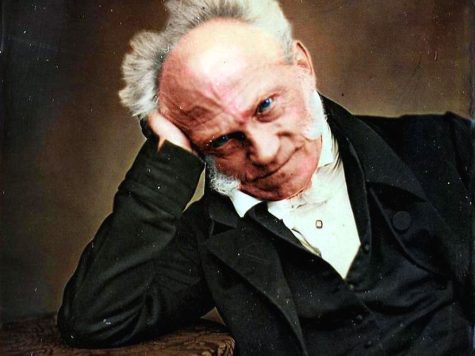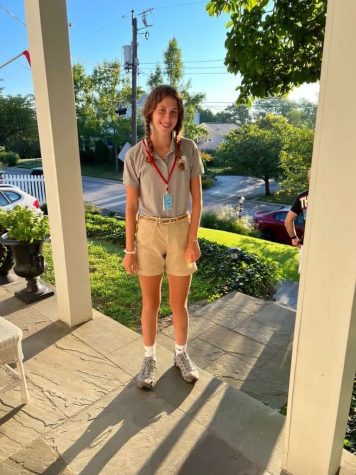Presidents’ Day 2022: The Warren Harding Presidential Library
February 25, 2022
Yet another Presidents’ Day has come and gone for me, and with it I got to experience yet another adventure. Last year, I corralled eight friends to come downtown with me to tour Cincinnati’s presidential statues, learn about Cincinnati’s connections to the presidency, and experience the Taft Museum of Art. This year, four friends and I drove 200 miles to visit the Warren G. Harding Home, Tomb, and Presidential Library and Museum. All three were amazing sites, so I thought I’d share this story in case you ever need a cool spot to road trip to with your family or friends on a weekend.
I would argue that my Presidents’ Day technically began with my presentation during assembly on the Thursday before the long weekend. I tried to turn a topic that some may find rather boring into a lively presentation, so I hope I succeeded in that goal.
After I got everyone in the Presidents’ Day mood, it was time to begin planning the actual day. The initial talk with my parents about driving 200 miles north to Marion, Ohio did not go well. After a thorough explanation of what we wanted to do, plus a stroke of good luck in the form of the nice weather that day, my parents let me go. We left at 9:30am and arrived around 1:20. Sometimes, finding yourself on a desolate road surrounded by Ohio soybean fields is relaxing.
When we finally sat down to eat lunch at a local diner on the side of the road, I knew that we were getting the full small-town northern Ohio experience. We arrived at the historic Harding home at 3:00 for the tour, and the main event of the day began.
If you ask most people what, if anything, they know about the 29th President of the United States, Warren G. Harding, they will probably say that he was a corrupt, womanizing president who died after being poisoned by his wife, the former First Lady, Florence Kling Harding. All three of those claims have varying degrees of truth. On the issue of corruption, Harding certainly did not pick the greatest cabinet in the history of the United States. Albert Fall and Charles Forbes, two high-ranking Harding Administration officials, were each sent to jail as a result of the Teapot Dome Scandal, one of the most famous cases of government corruption in U.S. history, and arguably the biggest until Watergate.
As I learned on my visit, however, there was more to his administration than just this scandal. President Harding advocated for a strong economy by cutting taxes and establishing the Bureau of the Budget, the federal agency that would later become the Office of Management and Budget. He pushed for American participation in global affairs, conserving but utilizing the natural resources of Alaska, and equal rights for all Americans. While speaking at a segregated dinner club in Alabama, President Harding went off the cuff to rail against segregation and the unfair treatment of African Americans. He fought for the passage of an anti-lynching bill that unfortunately ended up dying in the Senate, and advocated for the citizenship of Native Americans, a goal that would be completed by the Coolidge Administration following Harding’s death. These positive aspects of his presidency are not often remembered.
Harding did have major problems with his extra-marital affairs. One of the girls that he pursued was underage and the power position that he was in allowed him to take advantage of her. He also fathered a child with a young woman named Nan Britton, who was denied child support by Harding’s wife after his death. There is no excuse for these actions, and this rightly lowers his standing among the rankings of U.S. Presidents.
Finally, the claim that he was poisoned by his wife, Florence, is most likely untrue. While there is no definitive proof for either side of the theory, the facts point to heart problems for Harding that were never diagnosed, problems that most likely lead to his sudden heart attack. Florence also loved life in the White House, thoughts that she often wrote about. The death of her husband meant that she was forced to move out of the White House, something that she most likely would not have voluntarily brought about.
The tour of the home was exceptional. Stepping inside felt like stepping into 1920. The restoration work done in the last few years thoroughly accomplished this goal. The house is also spacious and airy, allowing for the entire tour group to comfortably experience the grandeur. President Harding’s famous straw hat, his favorite chair, and even a record player that he and his wife used are all original artifacts used to tell his story in the house. At one point, the tour guide explained to us that the bottom of the stairs, right where we were standing, was the spot where he and Florence were married. The lived-in feeling of the house allowed for an intimate connection to a long-dead U.S. President like I have never experienced before.
After we completed our tour of the house, we made our way to the newly completed Harding Presidential Library and Museum. Here, they told the story of a man who was determined to prove himself to those who doubted him by running for office and being elected to the U.S. Senate. At the 1920 Republican Convention, he emerged as a compromise candidate who went on to defeat the Democratic nominee, Ohio Governor James Cox, in an electoral landslide of 404-127. He nabbed 60.4% of the vote to Cox’s 34.1%, a true mandate of the people not seen in decades. He achieved this victory through his front porch campaign, a popular campaigning style for presidential nominees of the time. Thousands flocked to Marion to listen to Senator Harding speak on his patio.
Getting to stand on that same patio was a surreal feeling. Two of my favorite artifacts in the museum included the suit that he wore to his inauguration and the podium where he delivered the inaugural address. The pictures of him delivering the speech at the podium in the suit made the fact that those two objects were right in front of me even more incredible. The experience at the museum was phenomenal. It had unbelievable artifacts, insightful information, and a fun gift shop at the end.
We finished the day with a visit to a memorial one mile away: the Harding Tomb. After only seeing it in pictures, I was blown away by the real-life magnificence of this presidential grave. As we approached the park, the pillared monument towered like a Roman temple. It was impossible to miss. As we got closer, its size became much more imposing. Climbing the steps to the locked gate, we were able to peer through at the grassy bottom of the monument containing a single tree and two coffins – those of President and Mrs. Harding. After his sudden death in 1923, the people of Marion rallied to fund the titanic monument to their beloved hometown hero. In 1927, it was completed in accordance with President Harding’s wish to be buried beneath a tree and the open sky.
Standing in front of his gravesite after a day of learning so much about the storied life he lived was an indescribable feeling. He had ascended to the zenith of American political power, and here I was, after touring the very house he lived in, standing in front of the only earthly remnants of him. It was the perfect end to the day. I would highly recommend the day-trip to Marion to experience such a special and uniquely Ohio piece of American history.



